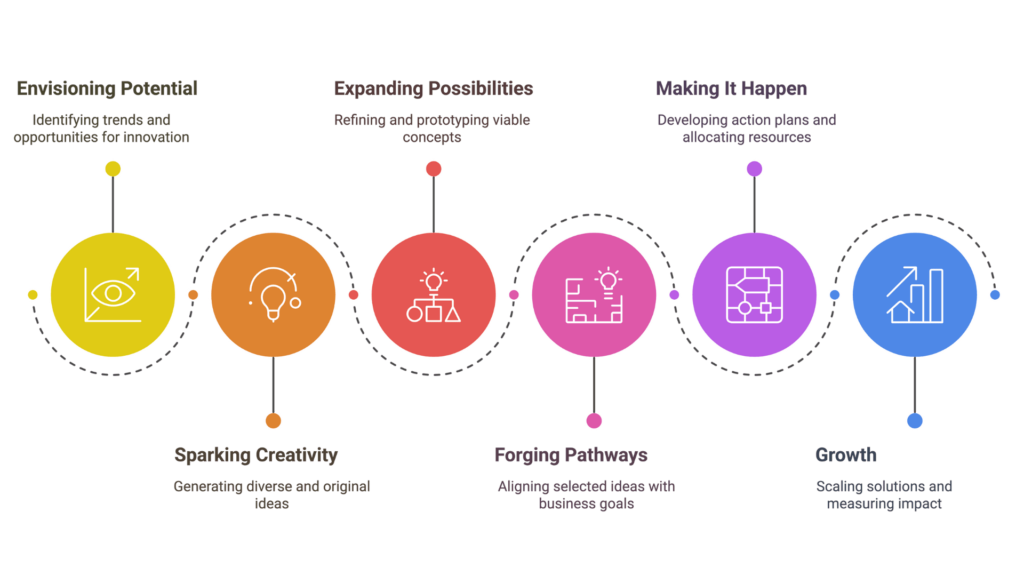Posted in Blog, Design Thinking, Innovation, Launch Your Business by Jo North
Jobs-to-be-done: An Introduction
Understanding customer needs is at the heart of successful innovation and product development. However, traditional methods like surveys or focus groups often miss the mark, failing to reveal the deeper insights that drive true customer decisions. That’s where the Jobs to Be Done (JTBD) framework becomes essential. By focusing on the jobs customers need to accomplish, rather than just the product or service itself, JTBD shifts your focus from creating features to creating solutions. This shift from a product-first to a customer-first mindset is what allows you and your business to truly innovate and stay ahead of market demands.
Clayton Christensen, the pioneer behind Jobs Theory, introduced JBTD to help innovators understand the functional job a product performs for its end users. It helps you shift from a product-first mindset to a customer-first mindset. And failing to understand customer jobs leads to missed opportunities or failed products.
Jobs-to-be-done and Your Value Proposition
Getting JTBD right is essential for creating a successful value proposition. A value proposition is all about how well your product solves the job that customers are trying to get done. If you don’t understand the job they need your product to do, you can’t create a relevant value proposition. JTBD helps you pinpoint customer pain points, identify unmet needs, and develop a proposition that speaks directly to those needs.
The value proposition isn’t just about what your product does, it’s about the outcome that your product enables. And in order to define that outcome clearly, you must first understand the specific jobs your customers need to accomplish.
When you get JTBD right, your value proposition will align perfectly with the job your customers are trying to perform. You’ll have a greater chance of creating a product that’s not just useful, but essential.
Jobs-to-be-done and The Big Bang Partnership Innovation Framework
Now that we understand the core of JTBD, let’s see how it fits within the Big Bang Partnership Innovation Framework, a process I’ve developed to help companies innovate effectively.

JTBD interviews are a useful tool in the Big Bang Partnership Innovation Framework. They help uncover customer pain points and the jobs customers need to get done, which is key to identifying the right innovation opportunities. The insights from JTBD interviews inform the design of solutions that address both functional and emotional jobs, ensuring your product resonates with the customer. By integrating JTBD into the framework, you can rapidly prototype, test, and refine your innovations, ensuring they stay aligned with real customer needs and deliver lasting value.
Step 1: Understanding the Jobs-to-be-done Framework
The JTBD framework focuses on the job that a customer is trying to complete in a specific context. Rather than looking at a product’s features or the customer’s journey in isolation, it centers on the job executor’s goals and challenges.
You need to see the job map—the entire process a customer goes through to complete a job. This goes from the initial switch event (when they realize they need a solution) to the buying decision (when they settle on a new product). You want to identify the specific jobs they’re buying your product to do and the pain points they encounter along the way.
Pain Points
Pain points are the specific problems, frustrations, or obstacles that customers experience in the process of trying to get a job done. These are the issues that create discomfort or inefficiency in the customer’s journey. They are often the reason why they seek out a new product or solution.
Pain points can manifest in several ways:
- Functional pain points: These are issues related to the performance or usability of a product. For example, a tool may be difficult to use, slow, or unreliable.
- Emotional pain points: These relate to how a customer feels during their experience. It might be frustration from not being able to achieve a goal, embarrassment from using a product that feels outdated, or anxiety about wasting time and resources.
- Time-related pain points: Customers may face issues with products that take too long to use or involve complex, time-consuming processes. In this case, the pain point is the lack of efficiency / requirement of too much effort.
- Financial pain points: High costs or hidden fees can create frustration and make customers feel that they’re not getting enough value for their money.
Understanding pain points helps you identify where your product can make a real impact. You can deliver a solution that eases or eliminates the discomfort, making it more likely that customers will adopt and remain loyal to your product.
For instance, a SaaS company might discover through JTBD interviews that users find their onboarding process too time-consuming. This functional pain point could then be addressed by streamlining the process, resulting in greater customer satisfaction and retention.
Step 2: Prepare for the Jobs-to-be-done Interview
The success of JTBD style interviews depends on having the right participants and asking the right questions.
- Identify the Right Customers: You need a group of people who have struggling moments and unmet needs in the area your product addresses. These are your job executors. Don’t limit yourself to current solution users—future customers can also offer valuable insights into what could work for them in the future.
- Ask High-Level Questions: Your goal isn’t to dive into specific features right away, but rather to understand the decision-making process. Ask about their current way of doing things and explore expressions of pain they experience in their day-to-day lives. This can uncover customer behavior that you can address with new features. Questions like, “What were you trying to do the first time you searched for a solution?” are a great way to begin.
- Set Up for Good Notes: Make sure your team takes good notes and documents specific information from each interview. These notes will help you identify trends and create job stories that guide your product development.
Step 3: Conduct the Jobs-to-be-done Interview
When conducting the interview, the key is to follow-up questions that get at the core of the customer’s motivation. These questions help you understand user motivation in a way that’s much deeper than traditional market research. You want to uncover how they felt at struggling moments, how they made their purchase decision, and what aspects of the current solution fell short.
Start with questions such as:
- What made you choose this product over others?
- Can you walk me through the the steps you took to find a solution?
- When did you realize the current solution wasn’t working for you?
It’s important that you draw out the customer’s specific goals and understand the forces of progress that drive customer decisions to get actionable insights rather than superficial feedback.
Jobs-to-be-done Interview Questions
Here are 10 additional questions you can ask during your JTBD interviews to get deeper insights into the customer’s job, their pain points, and motivations:
- What did you hope to achieve when you first started looking for a solution?
- Can you describe the specific situation that led you to start searching for a new solution?
- What was the most frustrating part of using your previous solution?
- What made you realize that your current solution wasn’t meeting your needs?
- What alternative solutions did you consider, and why did you ultimately reject them?
- Can you tell me about the last time you tried to use your current solution? What happened?
- What factors influenced your decision when choosing this product?
- How do you feel when your solution works or doesn’t work?
- How would your ideal solution improve the experience for you?
- What would make you stop using this product and look for something else?
Step 4: Analyze the Data
Once you’ve collected your data, look for patterns that reveal the unmet needs and pain points your product can address. Focus on:
- Functional jobs: What tasks are customers trying to complete?
- Emotional jobs: How do they feel during these tasks?
- Consumption chain jobs: What are the jobs that occur before or after the main job, but are equally important?
This will give you a deep understanding of the customer that will help you to build great prototypes and successful products.
The JTBD insights also play a critical role in Business Model Innovation. When you map out these insights, you can uncover new ways of delivering value, which might lead to innovative business models or pricing strategies.
Step 5: Use JTBD Insights to Inform Product Innovation
Here’s where the JTBD theory becomes powerful. Now that you have valuable insights from your interviews, you can use them to guide your product decisions.
- Define Your Job Statement: A clear job statement should describe the customer’s job and desired outcome. For example: “When I’m [job], I want to [desired outcome], so I can [end goal].”
- Design New Features: Using the insights you’ve gathered, start designing product features that specifically address pain points and improve the customer experience.
- Validate Quickly: As you develop a new feature or product, test it early with potential users to ensure it aligns with the jobs they’re trying to accomplish.
These insights can also directly impact your business model. If your JTBD interviews reveal that a customer segment faces a particular problem in a different context than expected, it might suggest a new market or an entirely different value proposition. As Clayton M. Christensen observes, disruption often comes from targeting overlooked customer segments with a unique value proposition that better addresses their jobs.
Step 6: Iterate and Improve
JTBD interviews need to be part of an ongoing process. After your initial product launch, continue talking to customers and refining your features. Continuously gathering feedback helps you stay aligned with customers’ evolving needs.
By constantly validating and adjusting your value proposition based on ongoing JTBD insights, you’ll ensure your product remains relevant and customer-centric. This also helps keep your business model agile and adaptable to changing customer preferences and market conditions.
Next Steps
Understanding Jobs to Be Done helps you move from building products to solving real customer problems. It shifts your focus from what the product does to the outcomes it delivers.
If you’d like to learn more about the Jobs to Be Done framework and integrate it into your innovation and product development process, I’d be happy to help. Whether you’re just starting to explore JTBD, need guidance on conducting effective interviews or would like some hands-on facilitation, we can provide the support you need to drive innovation and create solutions that truly resonate with your customers. If you’re looking to learn more about applying the Jobs to Be Done framework in your own product development process, let’s talk. I’m offering a free consultation where we’ll explore how JTBD can uncover valuable insights for your business. Contact me here to schedule a quick video call.


